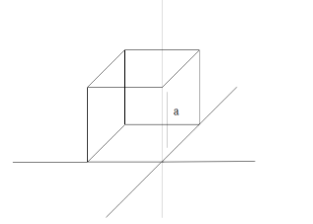
The moment of inertia of a cube of mass m and side (a) about one of its edges is equal to:
A. $\dfrac{2}{3}m{a^2}$
B. $\dfrac{4}{3}m{a^2}$
C. $3m{a^2}$
D. $\dfrac{8}{3}m{a^2}$
Answer
568.2k+ views
Hint: The perpendicular axis theorem is defined as that moment of inertia of a planar lamina about an axis perpendicular to the lamina which is equal to the sum of the moment inertia of the Lamina about the two axes at the right angle to each other in its own plane of intersection to each other.
Complete answer:

According to perpendicular axis:
$I = {I_C} + m{(\dfrac{a}{{\sqrt 2 }})^2}$
$ \Rightarrow (\dfrac{{m{a^2}}}{{12}} - \dfrac{{m{a^2}}}{{12}}) + \dfrac{{m{a^2}}}{2} = \dfrac{2}{3}m{a^2}$
$I = \dfrac{2}{3}m{a^2}$
The term moment of inertia is also known as mass moment of inertia. It is defined as the ratio of net angular momentum of a system to its angular velocity around the principal axis. Moment of inertia plays a very important role in physics which means that in physics problems that involve the mass in rotation motion and that are calculated by angular momentum.
So, the correct answer is “Option A”.
Additional Information:
THERE ARE THREE TYPES OF INERTIA:
a. INERTIA OF REST
b. INERTIA OF MOTION
C.INERTIA OF DIRECTION
If the moment of inertia is increased there will be a slowing down process of speed of rotation. We can also say that the moment of inertia of the body is directly proportional to the mass and it increases as the mass moves further from the axis of rotation.
Note:
Don’t get confused in saying that the moment of inertia and the inertia is the same in nature in physics. No it is not inertia means just the state of the body either it is in motion or rest whereas the moment of inertia is the measurement of resistances of the object against the rotation.
Complete answer:

According to perpendicular axis:
$I = {I_C} + m{(\dfrac{a}{{\sqrt 2 }})^2}$
$ \Rightarrow (\dfrac{{m{a^2}}}{{12}} - \dfrac{{m{a^2}}}{{12}}) + \dfrac{{m{a^2}}}{2} = \dfrac{2}{3}m{a^2}$
$I = \dfrac{2}{3}m{a^2}$
The term moment of inertia is also known as mass moment of inertia. It is defined as the ratio of net angular momentum of a system to its angular velocity around the principal axis. Moment of inertia plays a very important role in physics which means that in physics problems that involve the mass in rotation motion and that are calculated by angular momentum.
So, the correct answer is “Option A”.
Additional Information:
THERE ARE THREE TYPES OF INERTIA:
a. INERTIA OF REST
b. INERTIA OF MOTION
C.INERTIA OF DIRECTION
If the moment of inertia is increased there will be a slowing down process of speed of rotation. We can also say that the moment of inertia of the body is directly proportional to the mass and it increases as the mass moves further from the axis of rotation.
Note:
Don’t get confused in saying that the moment of inertia and the inertia is the same in nature in physics. No it is not inertia means just the state of the body either it is in motion or rest whereas the moment of inertia is the measurement of resistances of the object against the rotation.
Recently Updated Pages
Master Class 12 Economics: Engaging Questions & Answers for Success

Master Class 12 Maths: Engaging Questions & Answers for Success

Master Class 12 Biology: Engaging Questions & Answers for Success

Master Class 12 Physics: Engaging Questions & Answers for Success

Master Class 8 Maths: Engaging Questions & Answers for Success

Class 8 Question and Answer - Your Ultimate Solutions Guide

Trending doubts
Which animal has three hearts class 11 biology CBSE

1 Quintal is equal to a 110 kg b 10 kg c 100kg d 1000 class 11 physics CBSE

Explain zero factorial class 11 maths CBSE

Mention the basic forces in nature class 11 physics CBSE

What is centripetal acceleration Derive the expression class 11 physics CBSE

Bond order ofO2 O2+ O2 and O22 is in order A O2 langle class 11 chemistry CBSE




